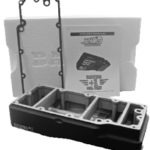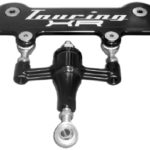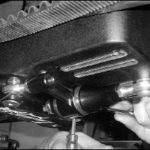The first production motorcycle to incorporate a conventional radiator-style oil cooler in its design was the BSA Rocket Three—back in 1968. Since then there have been quite a few others that offer oil coolers as standard equipment. Harley-Davidson is not one of them! That old British triple needed its cooler because the center of the three cylinders definitely ran too hot. Yet the real issue, then as now, is not the heat generated, but its efficient dissipation. Let’s look at it another way: All air-cooled engines shed heat through convection and radiation—period! Conventional oil coolers by nature do not change this fact. They only allow for an increase in the surface area available to get the job done. (Bigger fins, more of them, or barrels that simply live in un-shrouded air, like BMWs or Guzzis—are an effective approach as well.) Since no one’s really in the business of adding fins or changing air flow around their cylinders, increasing power (and heat) in a Harley V-twin traditionally left owners looking for oil coolers to help handle it. Not a solution without drawbacks, by the way.
One issue with oil coolers is the extra hoses and fittings and places to leak. Another is the burden on the oil pump and indeed the entire lubrication system. It’s not discussed much, but most Harleys, with their volume rather than pressure oiling, can suffer from poorly designed add-on oil coolers. If the oil (which will not compress) is required to sneak through smaller orifices or kinked lines (or faulty thermostats) it can strain the pump and starve (or sump) the engine. Better a little hot than not enough in the first place (or the right place). Thankfully, for Harley’s “touring” models, which tend to need cooling most, there is another way.
Baker Drivetrain has developed a damn clever part that cools the oil effectively, eliminates extra sources of leaks, puts no extra burdens on the lube system, and does one other rather intriguing thing—allows the lubricant itself to share the dissipation chores—by adding 25 percent more of it! It’s called the Plus-1 Oil Pan, but that name only reveals one aspect of the thinking that went into the design. For instance, the Plus-1 “pan” (which is really a sump) obviously cools oil (by 10 degrees or so) by adding more of it, but also tends to keep those temps more uniform throughout the system, avoiding the relatively hot and cold spots of conventional coolers (which are coolest in the cooler radiator, by the way). Because the pick-up and return drillings are only about two inches apart in the factory pan, yet at opposite ends of the Baker Plus-1, you also get the same type of relief from hot spots on any bagger. The baffles are cast in the Plus-1, rather than a plastic insert, as well. There’s no decrease in ground clearance either, since the Plus-1 is wider rather than deeper than the OE part. (Wider means more surface area to dissipate heat, too.)
The price is right at about $400 and installation is no more difficult and hardly different than replacement of the factory unit (although Baker’s instruction sheet for the Plus-1 plays it ultrasafe and adds a little work you probably won’t need to do). All in all, it seems this is a well-thought-out, beautifully engineered alternative to the add-on hose and radiator band-aid that we’ve been stuck with up until now. In other words, “sump’thin’’ that’s cooler than a cooler!
Here it is in black wrinkle finish. It comes with all the hardware, gaskets, seals and plugs, as well as a (possibly overly) detailed instruction sheet.
Here, in contrast to the plastic parts in the stock sump, you see the cast- in baffles and “tunnel” that routes oil clear to the rear of the sump…
…And here—the large diameter of the tube in the tunnel, which means no restriction to (cooler) oil flow…
…Which seems like a vast improvement over this tortuous, tight setup—brought to you by your typical oil cooler apparatus.
CVO-style cooler adaptors are better, but beyond the potential issues with the thermostat mechanism in the body, there are all those bent hoses and crimped clamps.
You can likely squeeze the Baker Plus-1 right back in where the stocker came out. The only tricky part is the screws for the middle of the pan, which you can hold in place with rubber bands whilst the pan is slid over the frame cross member. Yeah—it’s past snug on up into a tight fit, but should you decide to do it the hard way, just follow Baker’s advice and drop the swingarm pivot out of the way so you can crank up a little extra clearance.
That nifty boss appearing on the rear of the Baker Plus-1 is an open in-vitation to add another significant improvement to your rig—namely the Alloy Art TXR—to tame the wiggles in high-potency baggers. Installation need not be difficult but does require some forethought and double-checking.
You want to ensure that you can get the alloy mounts into the frame crossbar, past the Baker pan bottom, before you button anything down. You also need to double check that the screws are not so long they’ll hit the pan when torqued and shorten if/as required. Lastly, adjust the TXR mounting points so that there’s absolutely no side loads and the screws drop through their respective holes freely! There’s no torque figures in the instructions but sensibly tight (and some blue threadlocker) oughta do fine.




























